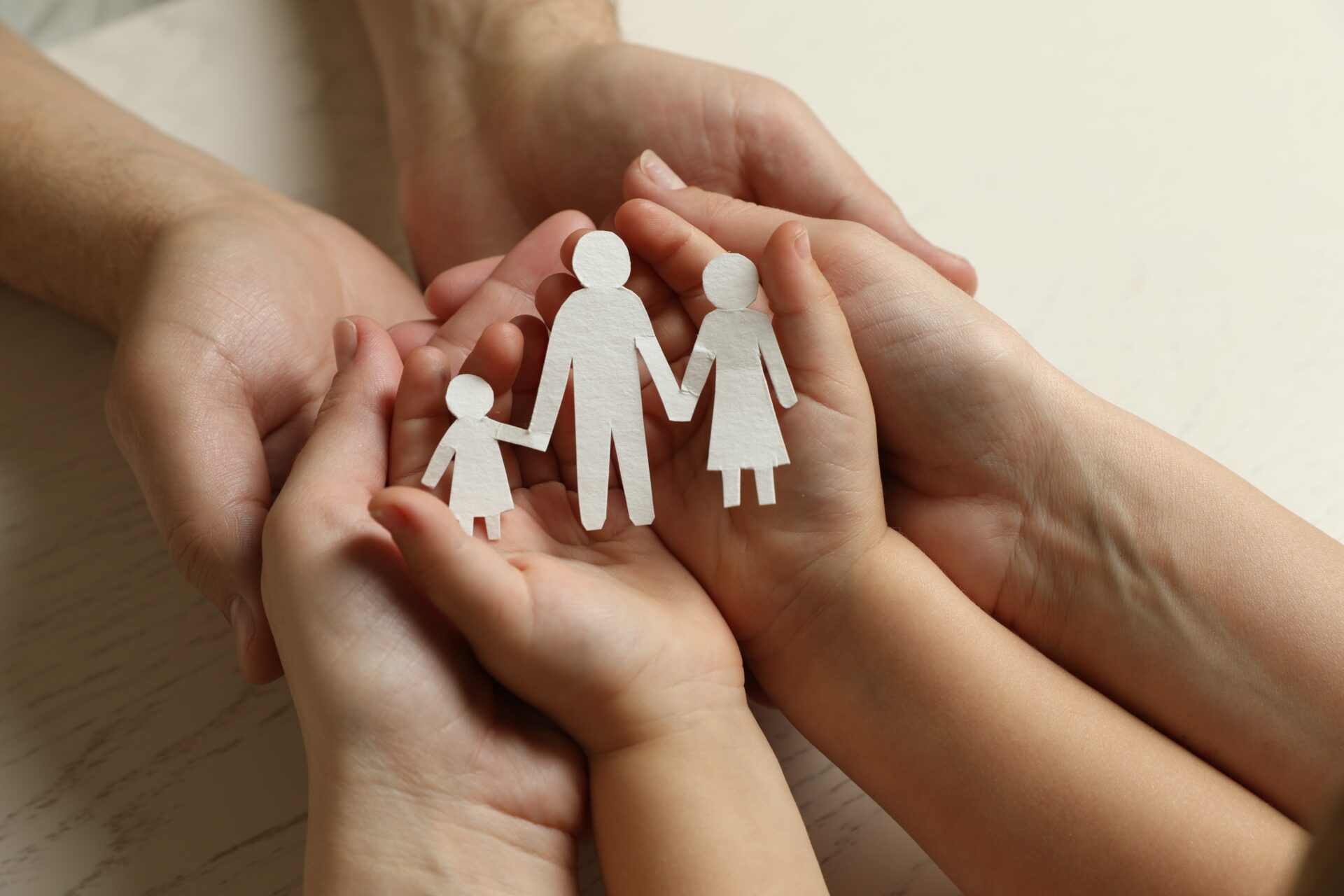Adoption is a legal process where parental rights are transferred to adoptive parents. However, far more than a legal transaction, this meaningful journey connects children needing permanent homes with adults ready to provide loving parental guidance.
While adoption involves complex emotions, preparation, and procedural steps, it offers a path to family formation that can profoundly benefit children and parents alike.

Pathways to Adoption
Adoption plays a meaningful role in building families across the United States. According to insights from the National Council For Adoption, approximately 80,600 children were adopted in 2022, the latest year for which NCFA data is available [1].
These adoptions reflect a wide range of experiences, from couples facing infertility and single adults ready to parent to same-sex couples growing their families and relatives stepping up to care for family.
While every adoption journey is different, they all share a common goal: creating safe, nurturing environments where children can thrive. Thus, prospective adoptive parents must meet specific eligibility requirements, which vary by state and adoption type.
In most cases, states have stipulations about who can adopt, and potential adopters undergo a rigorous screening process, including background checks, home studies, and interviews.
Beyond personal requirements, the adoption process varies depending on the path taken. Adoption options can be divided into four broad pathways: adoption from foster care, domestic infant adoption, intercountry adoption, and kinship adoption. Each route comes with its own legal procedures, timelines, and emotional considerations.
Adoption from Foster Care
Most adoptions take place through the foster care system. In 2022, there were 53,579 children adopted from foster care, down from a recent peak of 66,089 in 2019. These children represent diverse ages, backgrounds, and needs [1].
The process of adopting from foster care varies according to circumstances. Some people adopt an unrelated child while others pursue a “foster-to-adopt” path, where they first serve as foster parents to a child with the possibility of eventually adopting if reunification with birth parents becomes impossible.
Domestic Infant Adoption
Domestic infant adoption refers to the adoption of newborns or very young infants. Typically arranged through private agencies or attorneys, domestic infant adoptions totaled 19,658 in 2020 [2]. This pathway often involves an expectant mother selecting the adoptive family for her child, sometimes establishing a relationship before birth.
The domestic infant adoption process typically begins with a home study and the creation of a profile that birth parents review when considering adoptive families. Once matched, the prospective adoptive parents often support the expectant mother through pregnancy and delivery, though practices vary widely.
Intercountry Adoption
Intercountry adoption involves adopting a child who is a citizen of one country by parents who are citizens of a different country. Recently, intercountry adoptions to U.S. parents have declined significantly, from a peak of nearly 23,000 in 2004 to just 1,274 in 2023 [1].
The intercountry adoption process is governed by both U.S. immigration law and the laws of the child’s country of origin. A key distinction exists between Hague Convention and non-Hague adoptions.
The Hague Convention on Intercountry Adoption is an international agreement designed to protect children, birth parents, and adoptive parents by establishing uniform standards and preventing child trafficking.
When adopting from a country governed by Hague regulations, adopters must work with accredited agencies and follow specific protocols; whereas, non-Hague adoptions have different requirements.
Kinship Adoption
Kinship adoption occurs when relatives legally adopt a child from within their extended family. Grandparents, aunts, uncles, or other relatives step in to raise children whose parents cannot care for them due to various challenges, including substance use disorders, incarceration, mental health issues, death, etc.
While precise statistics are difficult to capture, research shows that 35% of 2020 adoptions through the foster care system were between stepparents or other relatives [3].
Open Adoption vs. Closed Adoption
The level of contact between adoptive families and birth families represents one of the most significant considerations in the adoption process. While related laws vary by state, the three main levels of adoption contact are [4]:
- Open Adoptions: Allowing for direct communication between birth parents, adoptive parents, and the adopted child, open adoptions provide children with access to biological family members, medical history, and answers about their origins. Conversely, they allow birth parents to maintain connections.
- Closed Adoptions: Prohibiting direct contact between birth and adoptive families, closed adoption arrangements typically include sealed adoption records, limited or no identifying information, no ongoing communication, and overall greater privacy.
- Semi-Open Adoptions: A third option offers a middle ground. Semi-open arrangements feature communication mediated through an adoption agency or attorney, exchanging non-identifying information and updates, and flexibility to adjust boundaries in certain circumstances.
The degree of openness in adoption may evolve over time based on the child’s needs and the comfort levels of all family members involved.
The Adoption Process
Most people contemplating adoption have myriad questions regarding everything from the process itself and how long it takes to the elements of a home study. However, answers are somewhat hard to come by, as specific adoption procedures vary based on adoption type, state laws, and personal circumstances.
That said, most adoptions employ the following pre-placement, placement, and post-placement framework, which is designed to protect children’s best interests and prepare families for the lifelong journey of adoption:
- Preplacement: During this initial phase, prospective parents research adoption paths, select professionals to guide them, complete required education and training, and participate in a home study. This phase can also involve creating family profiles or dossiers for presentation to expectant parents or countries.
- Placement: When a potential match is identified, adoptive parents review available medical, social, and developmental information about the child before accepting the match. The placement phase includes travel arrangements to receive the child, whether domestically or internationally.
- Post Placement: After placement, families are often monitored via home visits or virtual check-ins to ensure positive adjustment. This phase includes completing any remaining legal requirements specific to the adoption type, court appearances for finalization of the adoption, and issuance of a new birth certificate if applicable.
How Much Does Adoption Cost?
Adoption expenses vary widely depending on the pathway chosen, with adoption from foster care being free or highly affordable. To provide a further ballpark, research from the National Council For Adoption indicates that domestic infant adoptions average $33,142 and intercountry adoptions average $36,776 [5].
Fortunately, multiple financial resources exist to help families manage adoption expenses. The federal Adoption Tax Credit provides significant relief, allowing families to claim qualified adoption expenses up to $16,810 per child as of 2024 [6].
Additionally, adoption grants from private foundations and religious organizations provide funds to qualified applicants, while specialized adoption loans offer favorable interest rates. Furthermore, many employers offer adoption benefits as part of their compensation packages.
Adoption and Mental Health
Despite the many rewards of adoption, the adoption journey presents unique mental health challenges and considerations for all involved.
Before adoption, prospective parents may experience significant stress related to failed infertility treatments, the application process, home studies, or unpredictable waiting periods. As such, many prospective adoptive parents struggle with anxiety, depression, or grief as they navigate complex emotions and practical challenges [7].
These emotions can be compounded when pursuing intercountry or kinship adoptions, where additional layers of complexity exist around cultural differences and complicated family dynamics. Many prospective parents also experience fears about adoption related to attachment, child development, or their own parenting abilities.
The transition period after a child joins the family brings additional mental health considerations. Like all new parents, adoptive parents can experience sleep deprivation, changes in relationship dynamics, and the stress of adjusting to new routines. However, adoptive families may face additional challenges related to a child’s pre-adoption experiences.
What’s more, parents and any pre-existing children face unique challenges when it comes to adoption and the family unit. Other children may struggle with altered roles or divided parental attention. In fact, adoption creates a sort of psychological reorganization for all family members as they adjust to new relationships, roles, and identities.
This reorganization can be particularly pronounced in transracial or transcultural adoptions, where families must navigate additional identity considerations and potential societal biases while helping children develop positive self-concepts that incorporate all aspects of their heritage [8].
Therapy for Adoptive Families
Therapy’s role in adoptive families’ lives extends throughout the adoption journey, from pre-adoption preparation to post-adoption adjustment and ongoing family development.
Professional mental health support can strengthen family functioning while addressing the unique aspects of adoptive family formation and dynamics. Plus, therapy provides valuable tools for navigating the complex emotional terrain of adoption, helping families build resilience and connection.
Before adoption, therapists can help prospective parents process any grief related to infertility, develop realistic expectations, and prepare for potential challenges. During this time, therapy also offers strategies for managing stress and anxiety while building skills for future parenting. After placement, therapeutic support becomes particularly valuable as families adjust to their new way of life [8].
Throughout the entire process, adoption-competent therapists understand the unique needs of adoptive families. They can address attachment concerns, behavioral challenges related to early trauma, and communication difficulties that may arise.
Plus, for children adopted at older ages or after significant adverse experiences, specialized trauma-informed approaches help address emotional and behavioral needs while supporting healthy development.
Building Families Through Adoption
Whether through foster care, domestic infant adoption, inter-country adoption, or kinship arrangements, adoption creates families bound by commitment rather than biology alone. The journey to and through adoption involves thoughtful preparation, education, and ongoing adjustment as families navigate complex emotional terrain together.
While adoption comes with unique challenges, from navigating the initial process to addressing children’s questions about identity and history, it also offers profound rewards.
With appropriate support, like adoption-competent therapy, financial assistance, and community resources, adoptive families can build resilience and connection. Each adoption represents a unique story of belonging, one that acknowledges complexity while celebrating the enduring bonds that make a family complete.
- Drumm, A. R., Davi, N., & Hanlon, R. (2025). Adoption by the numbers: 2021 & 2022. National Council For Adoption. https://adoptioncouncil.org/wp-content/uploads/2025/03/Adoption-by-the-Numbers-2025.pdf. Accessed 15 May 2025.
- National Council For Adoption. (2020, November 13). Domestic infant adoption. National Council For Adoption. https://adoptioncouncil.org/article/domestic-infant-adoption. Accessed 15 May 2025.
- National Council For Adoption. (2023, March 22). Kinship adoption. National Council For Adoption. https://adoptioncouncil.org/article/kinship-adoption. Accessed 15 May 2025.
- Gilmore, J.D. (2024, November 13). Open vs. closed adoptions. Findlaw. https://www.findlaw.com/family/adoption/open-vs-closed-adoption.html. Accessed 15 May 2025.
- Hanlon, R., & Quade, M. (2022). Profiles in adoption: A survey of adoptive parents and secondary data analysis of federal adoption files. National Council For Adoption. https://adoptioncouncil.org/wp-content/uploads/2022/07/Profiles-in-Adoption-Part-One.pdf. Accessed 15 May 2025.
- Hanlon, R., Wilmoth, B. (2025 January). Understanding the adoption tax credit. National Council For Adoption. https://adoptioncouncil.org/publications/understanding-the-adoption-tax-credit. Accessed 15 May 2025.
- National Alliance on Mental Health. (n.d.). Mental health for new parents. https://www.nami.org/your-journey/maternal-new-parent-mental-health/mental-health-for-new-parents. Accessed 15 May 2025.
- American Association for Marriage and Family Therapy. (n.d). Adoption. American Association for Marriage and Family Therapy. https://www.aamft.org/AAMFT/Consumer_Updates/Adoption.aspx. Accessed 15 May 2025.
The Clinical Affairs Team at MentalHealth.com is a dedicated group of medical professionals with diverse and extensive clinical experience. They actively contribute to the development of content, products, and services, and meticulously review all medical material before publication to ensure accuracy and alignment with current research and conversations in mental health. For more information, please visit the Editorial Policy.
We are a health technology company that guides people toward self-understanding and connection. The platform provides reliable resources, accessible services, and nurturing communities. Its purpose is to educate, support, and empower people in their pursuit of well-being.
Linda Armstrong is an award-winning writer and editor with over 20 years of experience across print and digital media.
Shivani Kharod, Ph.D. is a medical reviewer with over 10 years of experience in delivering scientifically accurate health content.
The Clinical Affairs Team at MentalHealth.com is a dedicated group of medical professionals with diverse and extensive clinical experience. They actively contribute to the development of content, products, and services, and meticulously review all medical material before publication to ensure accuracy and alignment with current research and conversations in mental health. For more information, please visit the Editorial Policy.
We are a health technology company that guides people toward self-understanding and connection. The platform provides reliable resources, accessible services, and nurturing communities. Its purpose is to educate, support, and empower people in their pursuit of well-being.


